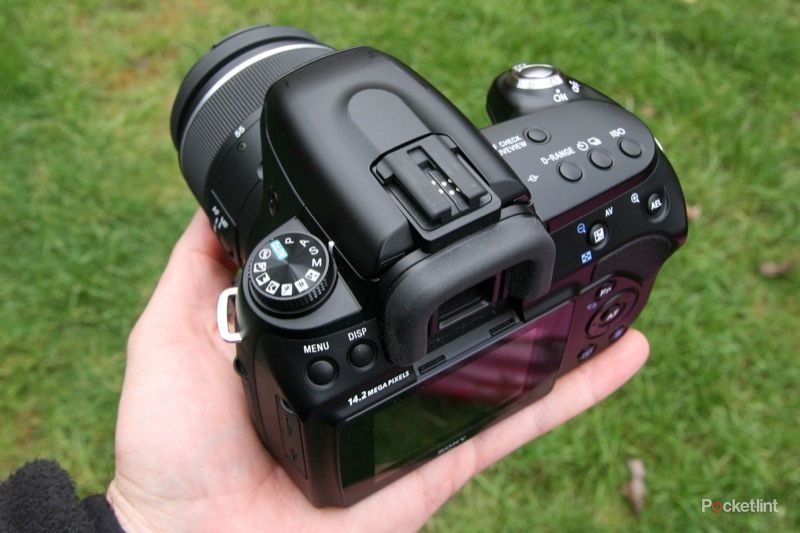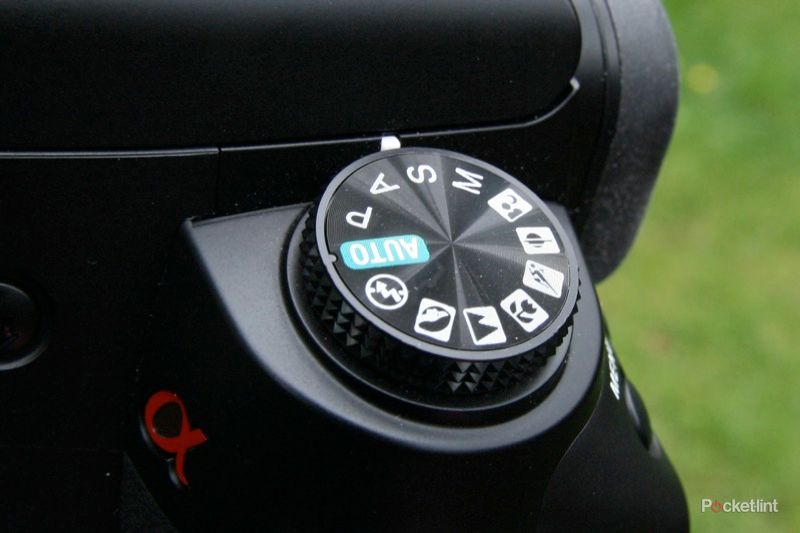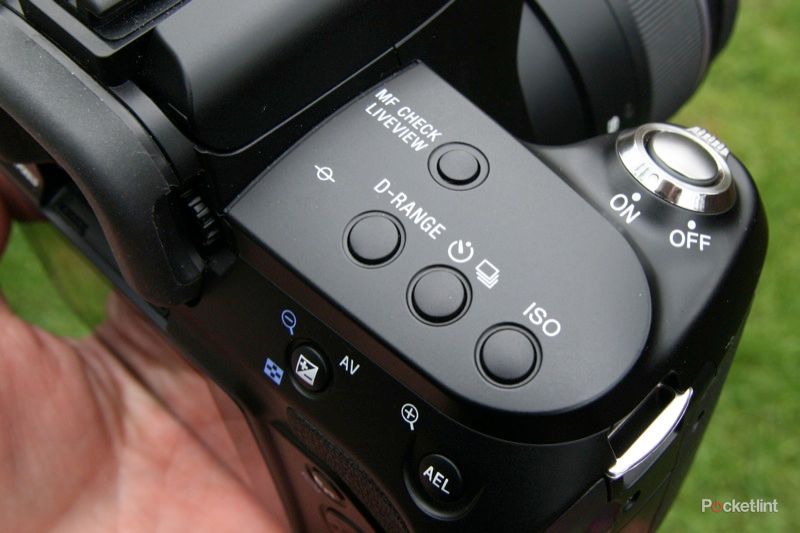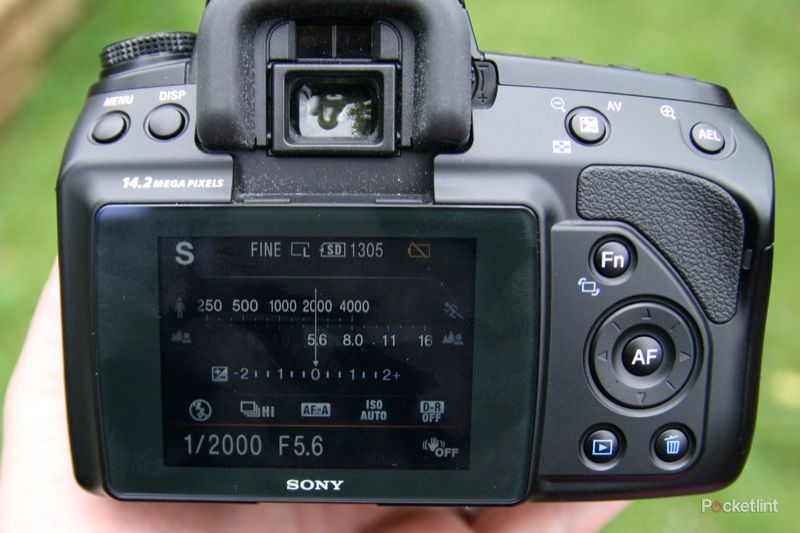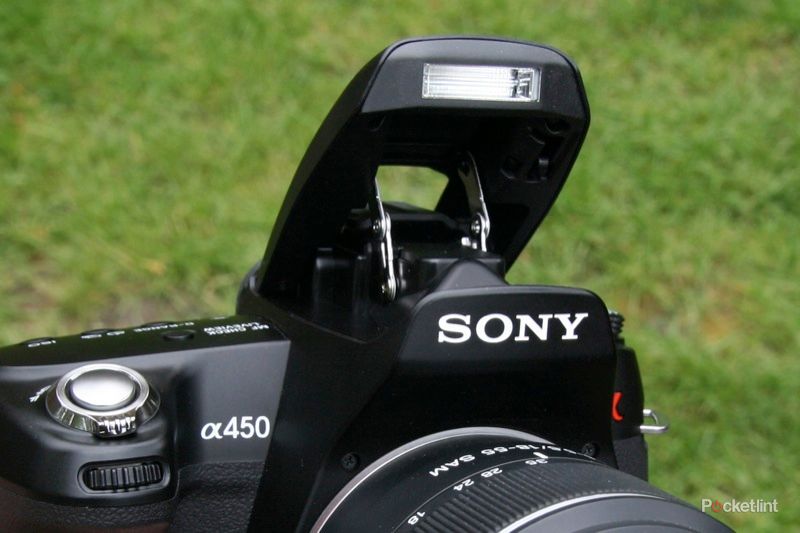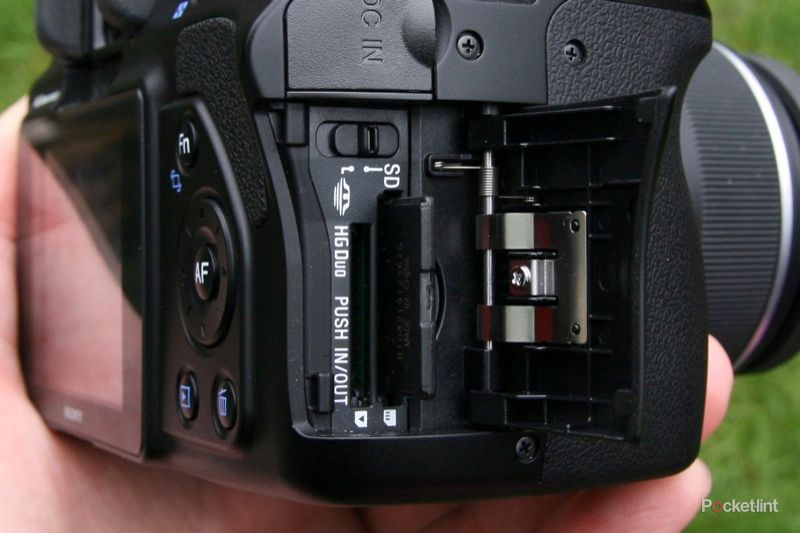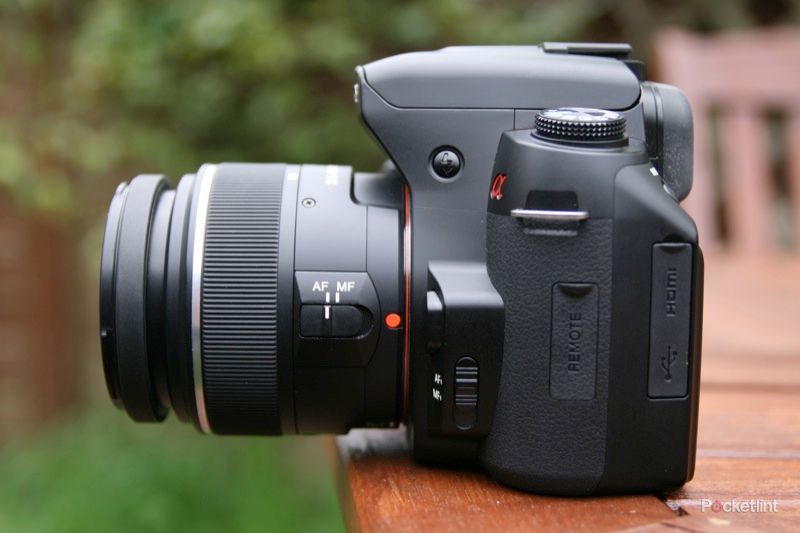The Sony Alpha 450 occupies a strange space: it blends something of an entry-level offering with fast frame rate that would catch the eye of an enthusiast. In doing so it can boast that it achieves something that few other affordable DSLRs do, but at the same time, it misses some more obvious tricks.
Our quick take
So overall the Sony Alpha 450 is something of a mixed bag. The fast frame rate might appeal to those interested in capturing action, but the biggest problem is likely to be the focusing system, which won't always give you what you want quickly and easily and the kit lens. The live view system lacks the AF too, so becomes less useful unless you are going to dive into manual focused static or macro work.
In terms of imaging results the A450 comes across as average, but then at this price point you're talking about an entry-level system and adding a better lens will certainly improve the results and make for a better overall package: a quality zoom for those who want to capture detail from the sidelines of a pitch, or hunting wildlife. A touch of post-processing brings out the detail too.
It's certainly a fun camera to play with, but we suspect that many will look towards rival models that offer more compact models with similar specs, as well as a toe into the world of video.
That fast capture though leaves you perplexed and making the Alpha 450 something of a odd ball.
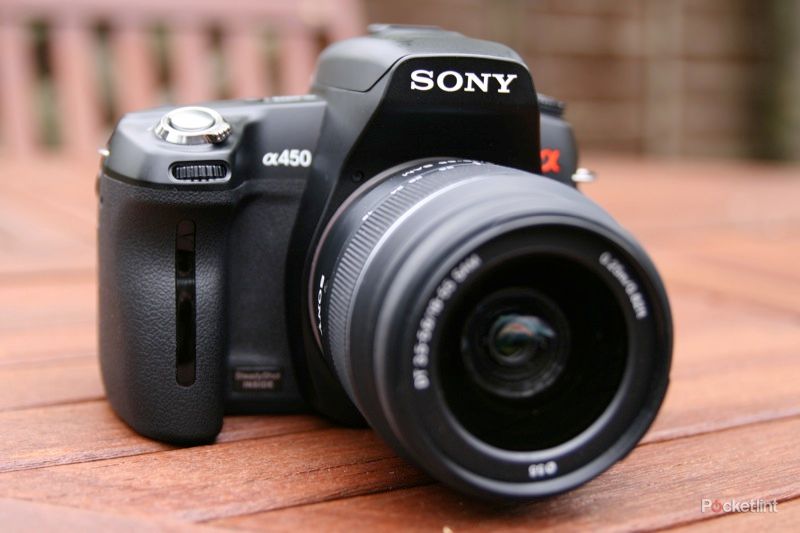
Sony Alpha 450 DSLR camera - 3.5 / 5
| FOR | AGAINST |
|---|---|
|
|
If there is one line of cameras that are consistently bullied at DSLR school, it's the Alphas. They've never been blessed with the best looks which is something of a surprise given Sony's design flair elsewhere. Even comparing it to rival models from 5 years ago it is rather large and looks rather dated.
But that's not enough to deter a DSLR user, who ultimately is more interested in performance, usability and accessibility to a family of compatible accessories. Being a Sony Alpha means it is compatible with A mount Konica Minolta lenses, so there is a huge range of glass out there which will fit this Sony model. We tested it with the 18-55 SAM kit lens, the standard zoom for this model.
So the A450 is constructed from plastics and it does look a little cheap. The layout of the controls, although easy enough to get to grips with, does look widely spaced, even toy-like from some angles. None of this really matters, but the screen and the viewfinder do suffer in their design.
The viewfinder offers 95% view of view, not ideal, but not uncommon, on amateur devices. It is unfortunately slightly recessed, with a step out to the 2.7-inch, 230,400-dot display. Space is set aside for various accessories to attach, like a screen hood, but in the process, we found we couldn't get as good an eye position as we'd like. The result is increased reflections from the surface of the viewfinder. We also found that the viewfinder was a little dark so what you see isn't what you get.
The main shooting modes of the A450 are set using the mode dial on the left shoulder, offering the usual array of manual and preset options. Of note is the "no flash" mode, a nod to those who don't want to make the three button presses you'd need to disable the flash in Auto, or switch the other way to the P, or program, mode.
Elsewhere on the dial you'll find the normal aperture and shutter priorities and full manual controls. The presets give you the normal run down of portrait, landscape, sports, macro, etc.
The power on/off encircles the shutter button and falls into a convenient place to power on or off with the camera up to your eye and ready to shoot. A dial lies on the front of the deep handgrip, where you can change values – aperture, shutter speed or ISO, for example.
There is a grippy section on the rear for your right thumb, with exposure compensation and exposure lock falling easily within reach, the latter can be engaged either by holding the button, or toggled, depending on your preference. The ISO button is equally easy to reach, giving you access to the range which runs from 200-12,800, with a catch-all Auto mode, giving you 200-1600. Strangely there is no lower ISO than 200.
The other major controls on the top of the camera include the drive mode button, which opens up the headline 5fps or 7fps shooting (and self timers), the live view button and the dynamic range, both of which we'll look at later. On the rear of the camera you then have a four-way controller which gives you menu navigation centred around an ok/AF button.
Elsewhere there is a Fn, or function, button which opens up a quick menu which will let you change most of the normal settings: drive mode, flash, focusing mode and area, ISO, metering, exposure compensation, white balance, dynamic range, creative style (standard, vivid, black and white, etc). Some of these elements can be directly changed through their own dedicated controls, so it is never too hard to find what you ware looking for.
The display can be changed through various styles. The first is a nod to the sort of hand-holding you find on entry-level Canon DSLRs with their CA mode. In this case you get two scales, showing you the aperture and shutter speed. Switch into aperture priority, for example, and you'll see how the shutter speed has to change to accommodate your selected aperture to maintain exposure. The scale is usefully illustrated, with a sharp landscape icon at the smallest apertures and a blurred background for the largest, giving you a hint to the best landscape or portrait settings.
Another display option divides all the major settings into boxes. Sony have missed a trick here, because you could have dived in and changed those settings (like Canon's Quick Menu offering) but you still have to dive in and use the Fn menus.
Other settings are accessed through the Menu button and the menus perhaps look a little sparse compared to some other DSLR cameras – you don't get bags of custom settings supplied – but at the same time, you can't set the max auto ISO, for example, something we always like to see. You get access to things like enabling Sony's SteadyShot INSIDE, which offers optical image stabilisation in the camera, so the benefits can be applied to any lens you stick on the front.
Physical connections are on both sides of the A450, offering the usual Mini-USB and HDMI connections as well as remote and DC points. No HDMI cable is supplied in the box (you'll need it to have the mini version of the connector on one end), but you can then hook up to your HDTV and view your images on your giant screen. A hot shoe lies on the top over an in-built pop-up flash.
The A450 offers live view with the press of the appropriate button on the top of the camera. This flips up the mirror, letting you see what is going on in front of the lens. It doesn't offer live autofocus however, so to focus, you have to press the AF button, which flips down the mirror, cutting off the live view, does the autofocus and then returns your focused scene, ready for you to press the shutter button.
It feels like something of a compromise. It doesn't present a problem if you are the sort of photographer who likes to manually focus on a tripod for a detailed still life shot, but for those who want to compose snappy over-the-head shots, it isn't brilliant. For those using manual focus, however, you can use the screen to confirm your focus is sharp, with the option of 7x or 14x magnification.
The operation, like the build, is somewhat clunky. The focusing is noisy and doesn't have the snap that some rivals offer, although that is going to vary from lens to lens. We also found the mirror movement to be both noisy and so dramatic that you feel as though you need a good grip to stop the mirror shaking the camera. It didn't appear to be a problem in our test shots, but the noise is obvious and distinct.
And yes, if you are going to deploy the 5 or 7fps shooting modes, the thing will be rattling off shots like a light machine gun. But it will turn heads and those around you will know that this is a rare feature indeed in a camera at this price. The number of continuous shots you can capture a 7fps depends on the file type: JPEG is cited as 32, RAW as 14 and RAW+JPEG as 7. We found this to be close enough: shooting JPEG to a SanDisk Extreme III SDHC card, it slowed noticeably at around 30, when it can no longer keep up with buffering.
Sports fans will probably be interested in this feature, remembering to select a fast shutter speed to capture the key moment. The faster 7fps locks the exposure and focus from the first shot; the "slower" 5fps will attempt to focus as it goes along, which usually means the frame rate drops whilst it tries to grab onto something.
Focusing offers you either single, continuous or auto. Single is the best option for still subjects and continuous is aimed at capturing fast moving subjects. Auto hovers between the two, trying to pick the best focusing method for the job. Focusing in general is noisy (mechanically) and not the fastest. We preferred to switch focusing modes manually, otherwise you can be stuck with the camera constantly whirring even when you aren't using it, trying to focus.
There is another focusing factor which is Eye-Start, which uses the eye sensor to trigger focusing so in theory the camera is focused and ready to use as you lift it up. Sound good on paper, but we turned it off, preferring the half-press of the shutter button once we had the scene composed through the viewfinder.
Through our test shooting we found that metering did tend to underexpose a touch, so images can be a little flat, with colours crushed. You do get various shooting styles, however, and the vivid setting might give you more vibrancy right out of the camera as an alternative to post-processing.
Of course you could opt to shoot RAW alongside JPEG, which will allow you to squeeze out more detail from your pictures and recover some of the elements that might otherwise get lost in conversion.
One of the other features that Sony have packed into the A450 though is a dynamic range system. This attempts to examine the scene and optimise the dynamic range (DRO), with 5 levels of intensity on offer. The differences are rather subtle, but you can see a lightening, for example, in foreground detail against the sky, that is lost when the system is turned off, although the colours don't always look totally authentic.
There is also an HDR setting which takes two shots of the scene and merges them in-camera – rather like you'd with a manual auto bracketing approach. The results aren't hugely dramatic and making the call over whether the results are better than the DRO equivalent is a tough one. Still, this being a system camera, you can easily add your own filters and techniques to get the effect you want.
We've already mentioned that the kit lens is rather noisy in focusing. It also seems to suffer from lens flare, which can be a pain when you get too close to the sun – although this can equally be used creatively. There is obvious distortion at the wide angle and we also found that at wider angles the viewfinder was blurry around the edges, which isn't great for composing shots. The lens also gives you some noticeable fringing in high contrast scenes.
Sitting at the core of the A450 is a 14.2-megapixel sensor and Sony's Exmor processor, which claims to keep the noise in check as the ISO rises. Noise is reasonably well controlled up to 1600, although the downside is a noticeable lack of detail as the processing cuts out the noise. Step over into the higher ISOs and you get very noisy images, with the headline 12,800 only really being suitable for those impossible shots to share online – although you can at least shoot these at full resolution which not all cameras will give you.
So we weren't blown away by the a450. It's a fun camera to use with the fast capture, if that's something you crave without spending more cash on a mid range model. There is no video offering in any form though, so this is a stills camera only, making it appear a step behind many rival models.
The build and generally chunkiness don't do it any favours, but it doesn't make the A450 a bad camera – it is still easy enough to find the features and settings you need. For some, the lack of some features will only make the camera simpler to use. This sort of jars against the fast shooting, leaving you wondering exactly who the A450 is pitched at: it serves up a platter of entry-level goodness with enthusiast dressing.
The battery life is uncharacteristically good for this level of camera – and without the distraction of video too. You'll get around 1000 shots from a single charge according to Sony: we managed to get over 600 shots with plenty of previewing, fiddling and fast capture without having to charge the battery, which is impressive.
To recap
That fast capture leaves you perplexed and makes the Alpha 450 something of a odd ball

